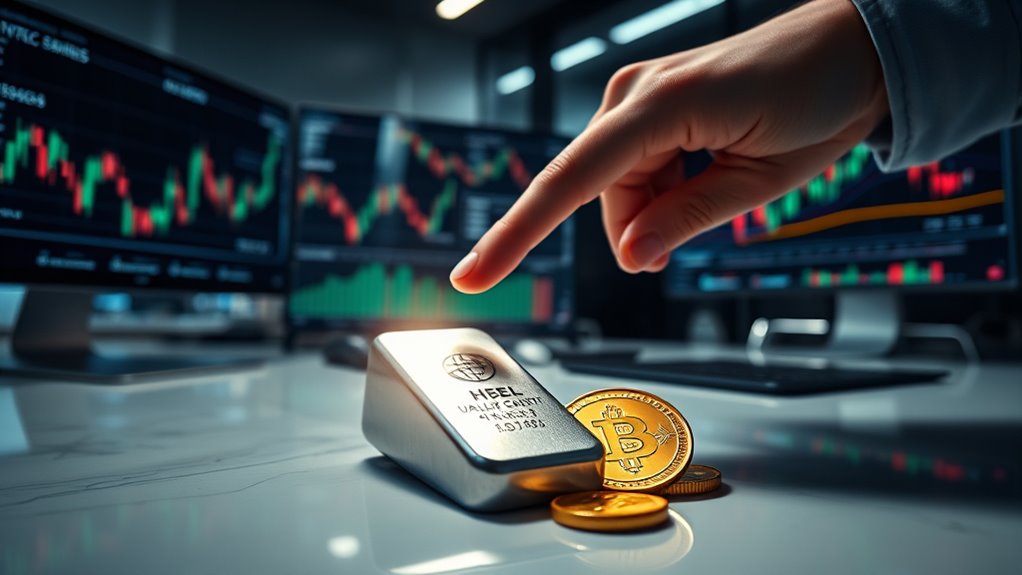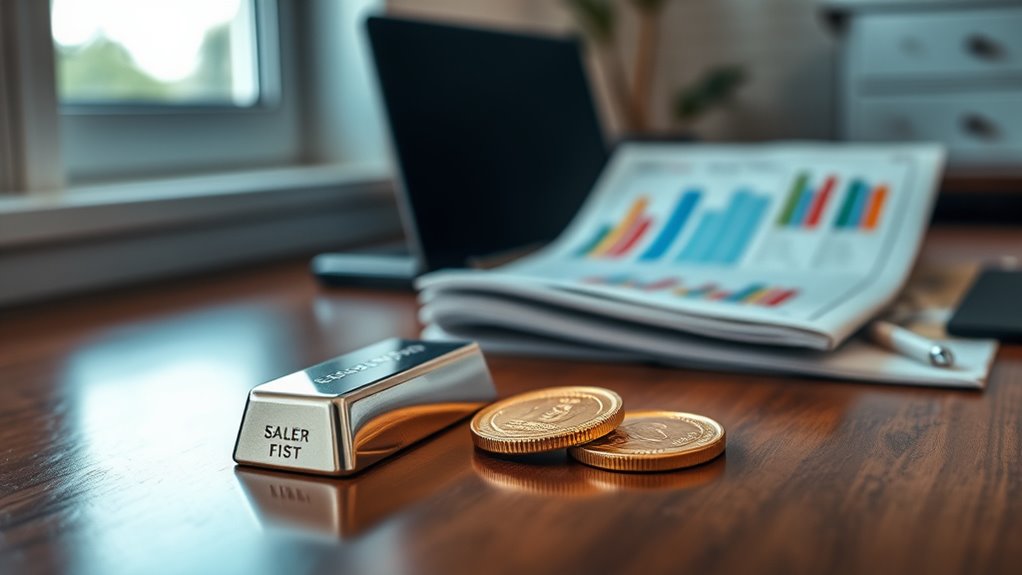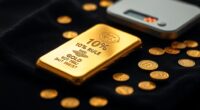Adding silver to a gold IRA can boost your portfolio when market conditions favor commodities, such as during periods of inflation or economic uncertainty. Silver provides extra diversification and can act as a hedge against inflation, especially when momentum shifts toward industrial metals. Tactical adjustments like this help strengthen your holdings during volatile times. If you want to understand how to time these moves effectively, there’s more valuable insight waiting for you.
Key Takeaways
- Adding silver boosts a Gold IRA during periods of rising inflation or economic uncertainty to diversify and hedge against risks.
- Silver enhances portfolio resilience when market momentum favors commodities and short-term opportunities arise.
- Tactical shifts toward silver occur when industrial demand supports silver prices, complementing gold’s inflation hedge role.
- Incorporating silver is advantageous during market corrections or volatility, providing additional diversification.
- Silver’s dual role as an industrial metal and store of value makes it strategic in market environments favoring commodities.

Have you ever wondered how savvy investors adapt their portfolios to changing market conditions? They often turn to tactical asset allocation (TAA), a dynamic strategy that actively shifts investments across asset classes to capitalize on short-term opportunities. Unlike a fixed, long-term approach, TAA responds to macroeconomic signals, market trends, and economic events, giving you the flexibility to adjust your holdings as conditions evolve. This approach aims to enhance risk-adjusted returns by taking advantage of temporary market inefficiencies while maintaining a broader strategic foundation. For example, during economic expansions, you might increase exposure to equities, while in downturns, shifting into fixed income or cash can help protect your assets. The goal is to manage risk more effectively and potentially reduce drawdowns during volatile cycles.
Savvy investors use tactical asset allocation to actively adapt their portfolios and capitalize on short-term market opportunities.
TAA differs from strategic asset allocation, which sets long-term targets and rebalances infrequently, regardless of market swings. Instead, tactical allocation permits deviations from these targets, allowing you to seize relative performance opportunities among asset classes—like increasing gold or commodities when market momentum favors them. This active approach often involves more frequent rebalancing, perhaps monthly or quarterly, to stay aligned with current market conditions. Both strategies, however, complement each other: strategic allocation provides stability, while tactical shifts add agility and potential for higher returns. Incorporating market timing into your tactical strategy can further optimize entry and exit points, maximizing gains and minimizing losses during volatile periods.
The process involves analyzing a range of factors—from inflation trends and geopolitical events to sector performance and economic cycles. Typically, tactical decisions are made over a horizon of three months to a year, with rebalancing occurring monthly or semi-annually. During these adjustments, you might increase your holdings in asset classes showing strength, such as equities during a rally, or reduce exposure to underperformers like certain commodities or bonds. Understanding the role of commodities helps investors make more informed tactical decisions. Incorporating commodity assets into your tactical decisions can diversify your portfolio and hedge against inflation. Silver’s unique position as both an industrial metal and a store of value makes it a strategic addition when tactical shifts point toward risk aversion or inflation hedging. Overall, integrating commodities into your tactical approach allows you to adapt quickly, enhancing your portfolio’s ability to weather changing economic landscapes.
Frequently Asked Questions
How Does Silver’s Volatility Compare to Gold’s?
You’re asking how silver’s volatility compares to gold’s. Silver tends to be more volatile because it’s influenced by industrial demand, market sentiment, and smaller supply. During economic swings, silver experiences larger price swings than gold, which remains more stable due to its status as a safe haven. While silver’s volatility has increased recently, it still generally exhibits higher fluctuations, making it riskier but potentially more rewarding during market upswings.
What Are the Tax Implications of Adding Silver to a Gold IRA?
Adding silver to your gold IRA has specific tax implications. You won’t face immediate taxes, as gains grow tax-deferred inside the IRA. When you withdraw, distributions are taxed as ordinary income. Holding silver within the IRA helps you avoid the higher collectible capital gains tax rates applicable outside the account. Just make certain your silver meets IRS purity standards and is stored properly with a qualified custodian to maintain tax benefits.
Is Silver More Suitable for Short-Term Gains Than Gold?
Since silver exhibits higher volatility and sharper price swings compared to gold, it’s generally more suitable for short-term gains. You can capitalize on silver’s rapid price movements driven by industrial demand and market trends, aiming for quick profits. Gold, on the other hand, offers stability and long-term preservation. If you’re comfortable with higher risk and seeking short-term opportunities, adding silver to your portfolio can boost your chances for faster gains.
How Does Market Timing Influence Silver’s Effectiveness in a Gold IRA?
Market timing plays a pivotal role in maximizing silver’s benefits in your Gold IRA. Silver’s prices can swing up to 20% in short periods due to industrial demand and economic shifts. By timing your purchases during economic expansions or dips, you can buy more ounces at lower prices, boosting your IRA’s growth. Staying alert to market trends helps you leverage silver’s volatility for better long-term returns.
Are There Specific Economic Indicators That Favor Silver Over Gold?
You should watch economic indicators like rising industrial demand, especially from electronics and green energy sectors, which favor silver. When geopolitical uncertainty and low interest rates occur, silver tends to perform well as a safe haven. Additionally, a high gold-to-silver ratio and market trends indicating undervalued silver signal it might outperform gold. Keep an eye on supply shortages and inflation pressures, as these can boost silver’s value relative to gold.
Conclusion
When you add silver to your gold IRA, you’re not just diversifying—you’re potentially boosting returns during market dips. Research shows that silver outperformed gold by 16% during the 2020 pandemic crash, highlighting its tactical advantage. Incorporating silver strategically can enhance your portfolio’s resilience and growth. So, when market volatility spikes, consider adding silver—it might just be the move that elevates your gold IRA’s performance and safeguards your investments.
Helen brings a wealth of experience in investment strategy and a deep passion for helping individuals achieve their retirement goals. With a keen understanding of market dynamics, Helen has been instrumental in shaping the vision and direction of Gold IRA Markets. She specializes in creating innovative solutions that align with our clients’ long-term investment objectives.










